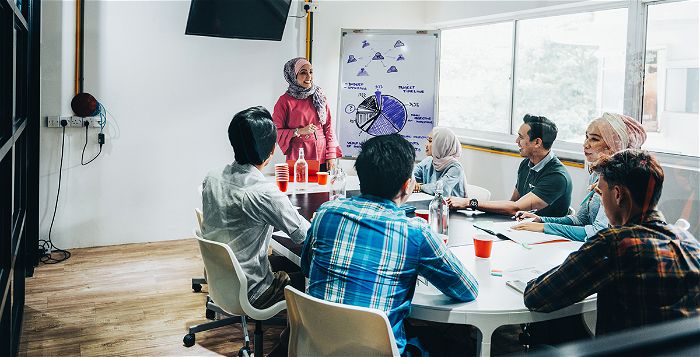
Outcomes for Opportunity
It’s becoming increasingly difficult to anticipate and predict changes in the labor market. The rapid pace at which jobs are evolving and shifts in the way people are preparing for them makes it difficult to…

September 29, 2021
The beta version of our insights and analytics platform offers compelling visualizations of workforce data.
Knowledge brokering—sharing lessons and ideas that benefit people—has always been a priority of organizations like ours. At JFF and the San Diego Workforce Partnership, we collect and share information about what works in the workforce development ecosystem to ensure that everyone has equitable access to jobs that offer opportunities for economic advancement. In partnership with other future-focused organizations, we have been working for years to find ways to take a more data-driven approach to this mission by unlocking the full potential of the data tools and technologies that are available to us.
Our work was inspired by the private sector, where companies have used sophisticated data collection and analysis systems to learn about their customers and better meet their needs for years. Our goal is to scale the use of similar technologies in the public and nonprofit sectors so that organizations committed to helping workers and learners prepare for in-demand jobs can operate more efficiently and effectively.
This work began in 2019, when JFF and Google.org launched the Outcomes for Opportunity (O4O) initiative—a two-year project whose goal was to enable workforce development boards and nonprofit job training providers to make better use of outcomes data. The San Diego Workforce Partnership joined the effort as a pilot site, along with Arapahoe Douglas Works! of greater Denver, and Workforce Solutions Greater Dallas.
With the introduction of our outcomes dashboards, we’re taking an important step toward fulfilling the O4O initiative’s goals. This beta version of our insights and analytics product features visualizations of workforce data provided by our pilot partners that the training providers and community organizations they work with can use to understand a broad range of topics, including career advancement, job attainment, and training costs.

A specific objective is to build data products that can help identify more immediate ways to improve the effectiveness of programs.
The Workforce Partnership found that participating in O4O led to insights about new ways to incorporate technology into its processes and presented opportunities to connect with other local workforce boards across the country and learn how they measure their performance.
At JFF, participation in O4O led to the development of a three-pillar project framework that includes the following elements:
At the most fundamental level, adopting a data-driven culture simply means using data to make decisions instead of relying on a purely instinct-driven approach to workforce development. In other words, decisions, investments, and partnerships should be driven in part by what the data and evidence presents, while decisions about what partnerships to pursue should be informed in part by where the data and evidence lead.
Just as JFF adopted a three-pillar strategy as part of its O4O work, the Workforce Partnership has committed to developing a data-driven strategy that advances five strategic pillars: inclusive business growth, job quality, outcomes-focused funding, population-specific interventions, and next-generation strategies. Among other things, the Workforce Partnership has set up internal data analytics and research teams that promote data literacy and stewardship throughout the organization and serve as a driving force of innovation in the community.

Organizations that collect and share data, and collaborate on its use, put themselves in a better position to answer questions like these: Does our work make a difference for the people we serve? Is it reaching the people who need it most in a timely manner? Is the impact sustainable over the long term? And how do we know whether any of our efforts or investments are working?
Additionally, policymakers and elected officials need data to shape policy proposals and legislative measures that expand the capacity of workforce boards.

For example, a Markle Foundation report titled “Unlocking Responsible Access to Data to Increase Equity and Economic Mobility” makes the case for improving access to data at all levels in order to help policymakers understand how policies and interventions are working and what gaps are being left unaddressed. Similarly, the Brookings Institution identifies “serious gaps in coverage in the labor and education data collected through unemployment insurance wage records” as one of the key problems limiting the effectiveness of labor and education data systems.
We have reached agreements with two leading tech companies, Domo and Brighthive, to join the O4O as partners to help us accelerate steps toward bridging those gaps. A Utah-based cloud software company, Domo is powering the data visualizations in the beta version of our platform. And Brighthive, which offers a solution that organizations can use to combine their data, supports efforts to help participating workforce boards form data collaboratives, establish data trusts, and design governance models.
But our efforts to scale O4O’s impact won’t stop there. We hope to establish new partnerships to expand our reach and improve our capacity to provide workforce boards and the communities they serve with state-of-the-art data tools. We’re seeking opportunities to work with philanthropic organizations, government agencies, nonprofits, and tech industry trade groups and professional organizations.

Of course, as we stand at the starting line, we see challenges that first arose at least a decade ago. But we also recognize that we can begin solving those problems if we make good use of the data collection and analysis tools that have grown increasingly sophisticated in that same 10-year time frame. The journey to becoming more data-driven starts with a realistic understanding of where we are, where we would like to go, and who we should work with to shape and achieve our goals.
Let’s not forget to make lots of noise and beat the drums highlighting both the challenges we need to address and the gaps we need to fill, as well as the solutions we can develop and the new pathways we can build. Awareness is important to keep key stakeholders engaged, and to signal to our colleagues throughout the workforce development ecosystem that this is an all-hands-on-deck opportunity to foster real change. And when it comes to addressing macro problems, the solutions we devise must be community-centric and community-driven. Thus far, we have navigated this crisis together, and that has redoubled our motivation to put all of our energy into this work.

It’s becoming increasingly difficult to anticipate and predict changes in the labor market. The rapid pace at which jobs are evolving and shifts in the way people are preparing for them makes it difficult to…

JFF will enable workforce boards to make data actionable, enhance programs, and improve outcomes for underrepresented Americans.

Future-Focused Workforce Board Behaviors | Workforce boards that collect and analyze a wealth of data are able to keep pace with and, in some cases, anticipate constantly changing regional dynamics. View the Full Brief It’s…